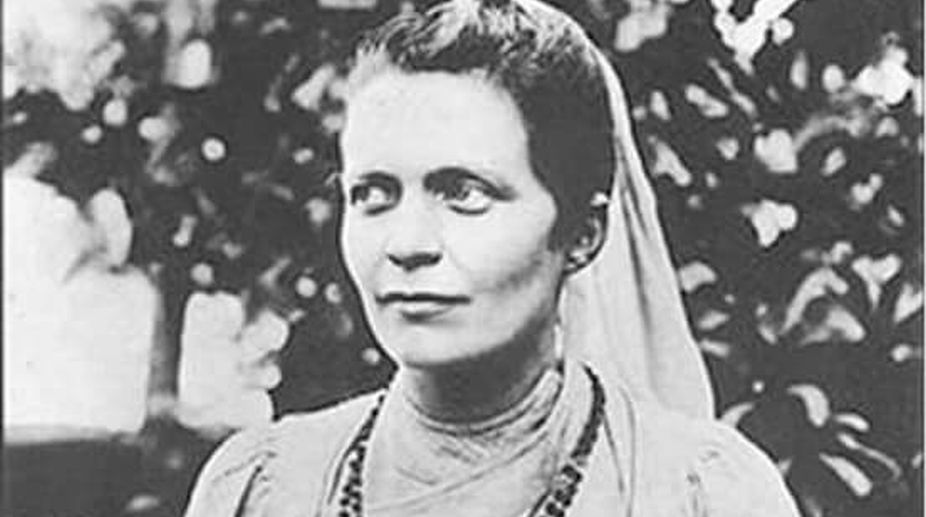PM Modi virtually launches PM-Suraj portal
The PM-Suraj portal was virtually launched by Prime Minister Narendra Modi today at Gana Bhavan in Uttarpara.

Sister Nivedita (Photo: Facebook)
Irish by birth and Indian by adoption, the life of Sister Nivedita (1867-1911), the illustrious disciple of Swami Vivekananda, is an epic of sacrifice, dedication and selfless service. She dedicated herself totally for the service of the people of India, specially of Bengal, and stood by their side in their hour of sorrow and distress.
When plague broke out in Calcutta in 1899 Calcutta, a committee formed under the auspices of Ramkrishna Mission with Nivedita as secretary, had organised relief work. She took an active part in the work without the thought that she herself might contract the disease.
Appeals for funds were made through newspapers by Nivedita. For encouraging the students to join the anti-plague operations, she delivered lectures on ‘Plague and the Duty of Students’ at the Classic Lecture auditorium. Fifteen students immediately came forward and enrolled themselves as volunteers.
Advertisement
Nivedita was the moving spirit behind the anti-plague operations. Her ‘compassionate’ figure tended the sick everywhere. As part of the anti-plague measures, she undertook the cleaning of the rubbish and refuse with a broomstick and basket in hand in Baghbazar. Nivedita distributed leaflets containing instructions and precautionary measures on plague.
The anti-plague work organised by RKM, in which Nivedita played the leading role, was perhaps the first instance of organised voluntary effort in the field of social service in India.
Her relief work was so well-organised that it was highly praised by the District Medical Officer in his report ~ “During this calamity the compassionate figure of Sister Nivedita was seen in every slum of the Baghbazar locality. She helped others with money without giving a thought to her own condition. At one time when her own diet consisted only of milk and fruits, she gave up milk to meet the medical expenses of a patient”.
Nivedita strove to provide relief to the sick and the poor in complete disregard of her own health and comfort. She began nursing the ailing patients. Dr RG Kar, the eminent physician of the time, had paid tribute to Nivedita’s courageous and selfless sacrifice for the plague victims. He has mentioned Nivedita’s work in connection with the nursing of a child attacked by plague ~ “That morning I had been to see a plague-stricken patient in a slum in Baghbazar. Sister Nivedita had come to enquire about the arrangements made for the patient and to take upon herself the task of nursing him. I told her that the patient’s condition was critical. Having discussed with her the possibilities of hygienic nursing in the slums of the poor people, I asked her to take precautions. When I went to visit the patient again in the afternoon I saw Sister Nivedita sitting with the child on her lap in the damp and weather-beaten hut in that unhealthy locality. Day in and day out, night after night, she remained engaged in nursing the child in the hut, having abandoned her own house. When the hut was to be disinfected, she took a small ladder and began white-washing the walls herself. Her nursing never slackened even when death was a certainty. After two days, the child lay in eternal sleep in the affectionate lap of that merciful lady”.
In the localities of Baghbazar, Nivedita’s merciful presence was a familiar sight. Her work to alleviate the sufferings of the people during the outbreak of the plague won the admiration of all her contemporaries. She won the love and respect of the people with whom and for whom she worked.
Again during a terrible flood in East Bengal in 1906, Nivedita stood by the distressed despite the woefully inadequate scope for organised relief.. As soon as she heard about their distress, she left Calcutta and went to Barisal. Wading for miles through knee-deep water and mud, she went from village to village and gave material help to the people and consoled them in their moment of bereavement. The people accepted her service without hesitation.
The flood was followed by famine in July 1906. Despite failing health, Nivedita became restless and rushed to East Bengal to join the relief work with the sanyassins of Belur Math. The famine cast a deep influence on her and she has described her feelings in her book, Glimpses of Famine and Flood in East Bengal in 1906. After her return from relief work she suffered from malaria which took a toll on her health.
In one of his letters, Swami Vivekananda wrote to Nivedita: “The earth’s bravest and the best will have to sacrifice themselves for the good of the many, for the welfare of all”. Vivekananda was alluding to supreme self-sacrifice. Nivedita proved that she was worthy of her Guru and worthy of her name Nivedita, ‘the Dedicated’, that was given to her by her Guru.
Nivedita was always by the side of suffering humanity, moving among them like an angel. She was always present where there was misery and sorrow. She was in fact a ‘Mother of the people’. To quote Rabindranath Tagore: “We have not seen before, an embodiment of the spirit of motherhood which, passing beyond the limits of the family, can spread itself over the whole country”.
A great reformer, a talented writer, an astute educationist and a passionate fighter for India’s freedom, Nivedita won the hearts of Indians by her tremendous service to the nation. She had only fourteen years to serve her adopted Motherland, but what she accomplished was remarkable.
(The facts have been gleaned from Nivedita of India, Ramkrishna Mission Institute of Culture, Kolkata; The Story of Sister Nivedita by Pravrajika Atmaprana; A Soldier With A Flaming Sword, Sister Nivedita Statute Installation Commemorative Volume).
The writer is a former Associate Professor, Department of History, Sivanath Sastri College
Advertisement